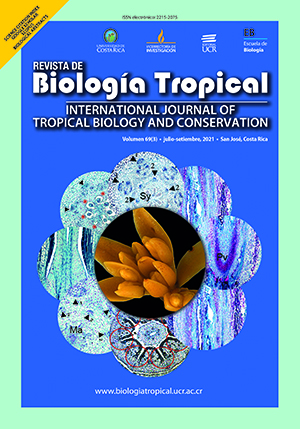Abstract
Introduction: Tree ferns are significant components of temperate, tropical and subtropical forests, contributing to shape complex forest stand structures. Objectives: 1) to describe the population structure of Cyathea costaricensis in a remnant cloud forest of West-central Mexico; 2) to characterize and relate the floristic composition and the structure of the most important tree species associated to the C. costaricensis population and; 3) to describe the environment where C. costaricensis occurs. Methods: We estimated the Importance Value Index (IVI) to select the most important canopy-dominant species associated to C. costaricensis; we constructed height and Diameter at Breast Height (DBH) frequency distributions for those selected species according to IVI as well as for C. costaricensis population; we computed the asymmetry of the frequency distributions through the coefficient of skewness and the probability density function via the Kernel density estimation. We tested for differences between canopy-dominant tree species and C. costaricensis population structure by the non-parametric Wilcoxon rank sum test. Results: C. costaricensis individuals presented the smallest heights and intermediate DBH sizes as compared with the canopy-dominant species, with statistically significant differences for height but not for DBH according to the Wilcoxon test. Most of the tree fern individuals were located in uneven terrains and over the base slope of the terrain; canopy openness and Total Radiation Under the Canopy values were similar to those reported for Cyathea species elsewhere. Conclusions: We confirm the hypothesis of comparable structure between the canopy-dominant species and the C. costaricensis population only for DBH; on the contrary, for trunk height, there were statistically significant differences; the small heights of C. costaricensis suggest their coexistence in the understory through sheltering from the taller canopy-dominants. Mostly all individuals of C. costaricensis were confined to local environmental conditions, particularly to physiography.
##plugins.facebook.comentarios##

This work is licensed under a Creative Commons Attribution 4.0 International License.
Copyright (c) 2021 Revista de Biología Tropical



